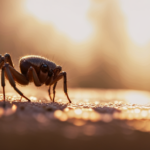Beginners Guides
How Long Do Those Tiny House Flies Live
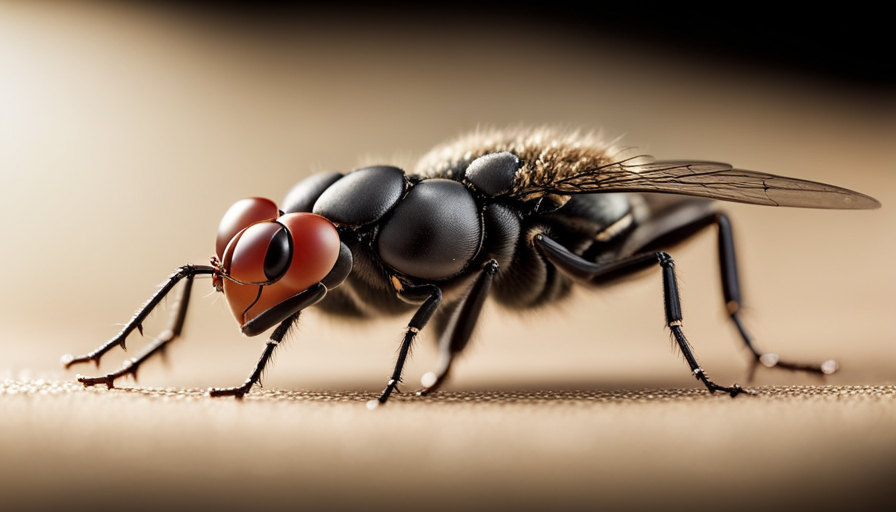
Picture yourself on a balmy summer’s day, lounging on your porch and basking in the mild wind. However, this serene escape is abruptly disturbed when a small house fly whizzes by your ear. You attempt to swat it away, eager to eliminate this annoying pest, but have you ever pondered the lifespan of these diminutive beings?
In this article, we will delve into the fascinating world of house flies and explore the intricate details of their lifespan. From the moment they emerge from their eggs to the final stages of their adult lives, we will uncover the secrets of their existence. We will also discover the average lifespan of house flies, as well as any exceptional cases that defy the norm.
By understanding the lifecycle of these tiny insects and implementing effective control measures, we can better manage their populations and maintain a more comfortable living environment. So, let’s embark on this scientific journey and uncover the mysteries of how long those tiny house flies truly live.
Key Takeaways
- Female house flies can lay up to 500 eggs during their lifetime.
- The lifespan of a house fly can range from a few weeks to a couple of months, influenced by factors like temperature and reproduction rate.
- Warmer temperatures accelerate the development of house flies, while colder temperatures extend their lifespan.
- Understanding the factors that contribute to house fly longevity is important for population control and minimizing their presence.
The Life Cycle of a House Fly
The life cycle of a house fly is a fascinating process that includes four distinct stages, each with its own unique characteristics. Understanding the life cycle of a house fly is important for controlling their populations and preventing infestations.
House flies, scientifically known as Musca domestica, are known for their rapid reproduction and ability to adapt to various environments. They have a wide range of behavior and can be found in both indoor and outdoor habitats. They are attracted to decaying organic matter, such as garbage, feces, and rotting food. House flies are also known to inhabit areas near livestock and poultry facilities, as they are attracted to the manure produced by these animals.
The first stage of the house fly life cycle is the egg stage, which lasts for around 24 hours. Female house flies can lay up to 500 eggs during their lifetime. These eggs are usually laid in batches and can be found in moist areas, such as rotting organic matter or animal feces.
In the subsequent section about the egg stage, we will explore the process from birth to hatching and how it contributes to the overall life cycle of a house fly.
The Egg Stage: From Birth to Hatching
From birth to hatching, it’s a mesmerizing journey for these little creatures. The life cycle of a house fly starts with the egg stage, which is a crucial step in their development.
The birth process begins when a female house fly deposits her eggs on a suitable substrate, such as decaying organic matter. Each female fly can lay up to 500 eggs in her lifetime. These small, white eggs measure about 1.2 millimeters in length and resemble grains of rice.
The hatching duration varies depending on environmental conditions, but it typically takes around 8 to 24 hours for the eggs to hatch. During this time, the eggs undergo embryonic development, where the larvae grow inside the protective shell. As the hatching process nears completion, the eggs darken in color, indicating the imminent emergence of the larvae.
As the eggs hatch, the next stage of the house fly’s life cycle begins: the larval stage. During this phase, the larvae actively feed and grow, setting the stage for their transformation into pupae. The larval stage is a crucial period for the house fly’s development, as it provides the necessary nutrients for their growth and prepares them for the next stage of their lifecycle.
Moving on to the larval stage: feeding and growing, the house fly larvae undergo remarkable changes as they continue their journey towards adulthood.
The Larval Stage: Feeding and Growing
During this stage, the wriggling larvae voraciously devour decaying matter, fueling their rapid growth and transformation. The feeding habits of these tiny house fly larvae are an essential part of their life cycle stages. As they hatch from eggs, the larvae immediately start searching for decaying organic material to feed on. They have a strong sense of smell, which guides them towards their preferred food sources.
Once they find suitable matter, they use their mouthparts to scrape and ingest it. These larvae are not picky eaters and will consume a wide range of decaying substances, including food scraps, animal waste, and rotting vegetation. They play a crucial role in breaking down and recycling organic matter in the environment. Their feeding activity not only provides them with the necessary nutrients for growth but also helps to decompose organic material, contributing to the overall ecosystem.
As the larvae feed, they undergo multiple molts, shedding their exoskeletons to accommodate their increasing size. This process allows them to grow rapidly and progress through the larval stage. After a period of intense feeding and growth, the larvae reach a stage where they are ready to enter the next phase of their life cycle: the pupal stage.
During this stage, they undergo a remarkable transformation and development, preparing to emerge as adult house flies. Transitioning from the larval stage to the pupal stage, the tiny house fly larvae go through an incredible metamorphosis.
The Pupal Stage: Transformation and Development
Witness the incredible transformation and development as you enter the pupal stage, where these wriggling larvae undergo a remarkable metamorphosis. During this stage, the tiny house fly larvae, known as maggots, transform into pupae.
This transformation process involves a series of intricate physical changes that prepare the fly for its adult stage.
-
Exoskeleton Hardening: As the larvae enter the pupal stage, their soft exoskeleton undergoes a process called sclerotization. This hardening of the exoskeleton provides protection and support for the developing fly.
-
Internal Reorganization: Within the pupa, the larval tissues and organs undergo extensive reorganization. The digestive system, which was previously adapted for feeding on decaying matter, degenerates and is replaced by the adult digestive system.
-
Wing and Leg Development: One of the most significant physical changes during the pupal stage is the development of wings and legs. These appendages, crucial for the adult fly’s ability to fly and move, form and lengthen within the pupal case.
As the pupal stage concludes, the adult house fly emerges, ready to begin its reproductive journey. The incredible transformation and development witnessed in the pupal stage sets the stage for the adult stage’s vital processes, including reproduction and lifespan.
The Adult Stage: Reproduction and Lifespan
Get ready to witness the amazing reproductive journey and lifespan of adult house flies! The adult stage of a house fly’s life is focused on reproduction and plays a crucial role in the continuation of their species.
After emerging from the pupal stage, adult flies are ready to mate and reproduce. The duration of the reproductive phase varies, but on average, it lasts for about two weeks. During this time, female house flies can lay up to 500 eggs, which are deposited in favorable breeding sites such as decaying organic matter.
As the adult house fly ages, it goes through a natural aging process. Initially, the flies are vibrant and active, but as time passes, signs of aging become apparent. These signs include a decrease in flight activity, loss of appetite, and a gradual decline in overall health.
The lifespan of a house fly can range from a few weeks to a couple of months, depending on various factors such as environmental conditions and availability of food sources.
Understanding the reproductive duration and aging process of adult house flies is essential in comprehending their overall lifespan. Factors affecting the lifespan of house flies will be explored in the subsequent section, shedding light on the intricate interplay between the environment and the longevity of these tiny creatures.
Factors Affecting the Lifespan of House Flies
The lifespan of adult house flies can be influenced by a variety of factors, including environmental conditions and the availability of food sources. One major factor that affects the lifespan of house flies is temperature. House flies thrive in warm environments, with their ideal temperature range being between 77°F and 86°F (25°C and 30°C). In colder temperatures, their metabolic rate decreases, causing them to slow down and potentially die. On the other hand, extremely high temperatures can also be detrimental to their survival as they are unable to regulate their body temperature effectively.
To better understand the impact of temperature on the lifespan of house flies, consider the table below:
| Temperature (°F) | Lifespan (days) |
|---|---|
| 77°F | 28 |
| 86°F | 14 |
| 95°F | 8 |
| 104°F | 3 |
As shown in the table, higher temperatures significantly reduce the lifespan of house flies. It is important to note that these values may vary depending on other factors such as humidity and availability of food sources.
Considering the impact of temperature on the lifespan of house flies, it becomes evident that environmental conditions play a crucial role in their survival. In the next section, we will explore how other environmental factors can affect the lifespan of these tiny flies.
Environmental conditions
Immerse yourself in the world of house flies and discover how their existence is shaped by the ever-changing tapestry of environmental conditions. House flies, being ectothermic organisms, are highly influenced by the environmental conditions surrounding them. The effects of climate change have a significant impact on their lifespan and overall population dynamics.
-
Extreme temperatures: Fluctuations in temperature can have profound effects on the life cycle and longevity of house flies. High temperatures can accelerate their life cycle, resulting in shorter lifespans, while cold temperatures can delay their development and longevity.
-
Humidity levels: House flies thrive in environments with high humidity levels. Adequate moisture is essential for their survival, as it promotes the growth of the microorganisms they feed on. However, excessive humidity can also facilitate the spread of diseases carried by house flies, posing a risk to human health.
-
Pollution levels: The presence of pollutants in the environment can affect the lifespan of house flies. Toxic substances, such as pesticides and pollutants from industrial activities, can directly impact their health and decrease their lifespan.
These environmental conditions, influenced by climate change and human activities, not only affect the lifespan of house flies but also have implications for human health. As we delve into the next section about the availability of food and water, we will further explore the intricate relationship between house flies and their environment.
Availability of food and water
With the ever-changing environmental conditions, it’s fascinating to explore how the availability of food and water shapes the survival and behavior of house flies. These small insects have a relatively short lifespan, typically living for about 15 to 30 days. During this time, their access to food and water plays a crucial role in their overall health and ability to reproduce.
House flies are known for their ability to feed on a wide variety of organic material, including decaying matter, garbage, and even feces. Their mouthparts are specifically adapted for sponging up liquid substances, allowing them to extract nutrients from these food sources. Therefore, the availability of food is essential for their survival.
Flies are attracted to areas with abundant food resources, such as kitchens, trash cans, and animal waste.
Similarly, water availability is essential for the house fly’s survival. These insects require water for their metabolic processes and to maintain proper hydration. They are often found near moist areas, such as drains, wet soil, or even pet water bowls.
Understanding the influence of food and water availability on house flies is crucial in developing effective pest management strategies. By manipulating these factors, we can potentially control their population and minimize their impact on human health and hygiene.
Considering the significance of food and water availability, it is also important to examine the role of predators and diseases in shaping the population dynamics of house flies.
Predators and diseases
Imagine being a homeowner and discovering a web of hungry spiders lurking in dark corners, patiently waiting to pounce on any unsuspecting house fly that ventures too close. As a tiny house fly, I’m well aware of the constant threat that predators pose to my existence. The predator-prey dynamics in the world of house flies are crucial for understanding our population dynamics and the impact we have on human health.
Here are four key points to consider:
-
Spiders: These eight-legged predators are one of the most significant threats to house flies. With their quick reflexes and venomous bites, they efficiently capture and consume us, helping control our population.
-
Birds: Many bird species, such as swallows and sparrows, rely on house flies as a food source. Their aerial acrobatics and sharp beaks make them formidable predators, reducing our numbers and limiting our spread.
-
Bacteria and Viruses: House flies can serve as vectors for various diseases, including Salmonella and E. coli. These pathogens can survive in our bodies and be transmitted to humans through contact or contaminated food, highlighting the potential impact on human health.
-
Other Insects: Predatory insects like dragonflies and mantises also pose a threat to house flies. Their stealthy hunting techniques and sharp mouthparts make them efficient predators, contributing to our natural regulation.
Understanding the complex predator-prey dynamics and their impact on human health is crucial in managing house fly populations. Transitioning into the subsequent section about the average lifespan of house flies, it’s important to explore how these factors influence our survival and reproduction.
Average Lifespan of House Flies
Predators and diseases play a significant role in influencing the lifespan of house flies. However, there are other factors that also impact their longevity. As a researcher, I find it fascinating to study the average lifespan of these tiny creatures.
House flies typically live for about 15 to 30 days, although this can vary depending on various factors. One of the key factors influencing their lifespan is temperature. Flies thrive in warm environments, and higher temperatures can accelerate their development and shorten their lifespan. Additionally, temperature also affects the rate of reproduction and the survival of the fly larvae.
When the temperature drops, house flies become less active, and their lifespan may extend beyond the usual 30 days. On the other hand, in warmer climates, flies may only live for a shorter period. It is crucial to understand the impact of temperature on the lifecycle of house flies as it helps us predict their population dynamics and implement effective pest control strategies.
Understanding the average lifespan of house flies provides us with valuable information about their reproductive potential, population growth, and overall ecological impact. However, it’s also interesting to explore the exceptional cases of longevity and the factors that contribute to these outliers.
Transitioning into the next section, let’s now delve into the longevity records and exceptions observed in the world of house flies.
Longevity Records and Exceptions
Surprisingly, even the tiniest of creatures like house flies have been known to defy the odds and achieve remarkable longevity, proving that age is just a number.
While the average lifespan of a house fly is only around 15-30 days, there have been some exceptional cases where these tiny insects have lived much longer.
Various factors contribute to the longevity of house flies, including environmental conditions, the availability of food sources, and genetic variations within the population.
Research has shown that house flies raised in controlled laboratory conditions tend to have shorter lifespans compared to those living in their natural habitats. This suggests that environmental factors play a significant role in determining the lifespan of house flies.
Additionally, genetic variations within the species can also influence their longevity. Certain genetic traits may make some flies more resilient and better equipped to survive adverse conditions, allowing them to live longer than their counterparts.
Understanding the factors that contribute to the longevity of house flies is crucial for effective fly population control. By targeting the environmental conditions that promote their survival and reproduction, we can effectively reduce their lifespan and mitigate their impact.
This knowledge can help us develop strategies and techniques to control house fly populations and minimize their presence in our surroundings.
Tips for Controlling House Fly Populations
After discussing the longevity records and exceptions of house flies, let’s now focus on some practical tips for controlling house fly populations and preventing fly infestations.
It is crucial to take proactive measures to reduce the presence of house flies in our homes and surrounding areas.
Firstly, maintaining a clean and hygienic environment is essential. Regularly dispose of garbage in sealed bags and ensure proper sanitation practices. Clean up spills and food residues promptly, as these serve as attractive food sources for flies. Additionally, regularly clean your trash cans and keep them tightly closed to prevent flies from accessing them.
Secondly, consider implementing physical barriers to prevent flies from entering your home. Install window screens and door sweeps to keep flies out while allowing fresh air to circulate. Seal any gaps or cracks in walls, windows, and doors to minimize entry points.
In conjunction with these measures, using fly repellents and traps can provide an extra layer of defense. There are various commercial fly repellents available, as well as DIY solutions such as vinegar or essential oil-based sprays. Fly traps can also be effective, especially those that use attractants or sticky surfaces.
By implementing these strategies, we can significantly reduce house fly populations and minimize the risk of fly infestations. Understanding the lifespan of house flies will further enhance our ability to control and manage these pests effectively.
Conclusion: Understanding the Lifespan of House Flies
To effectively manage and control fly populations, it’s important to understand the lifespan of these pesky insects. The lifespan of house flies can vary depending on various factors.
On average, a house fly can live for about 15 to 30 days. However, this lifespan can be influenced by environmental conditions, availability of food sources, and the presence of predators.
One of the key factors affecting the lifespan of house flies is temperature. Flies thrive in warm weather, and their lifespan can be shortened in cooler temperatures. Additionally, the availability of food plays a crucial role. Flies require a diet of organic matter, such as garbage or decaying food. If their food sources are limited, their lifespan may be shorter.
Managing fly populations is essential in controlling their lifespan. Proper sanitation practices can help eliminate potential breeding sites and reduce the availability of food for flies. Regularly cleaning and disposing of waste, as well as keeping food covered and sealed, can significantly impact fly populations.
Understanding the lifespan of house flies is crucial in effectively managing and controlling their populations. Factors such as temperature and food availability can influence their lifespan. By implementing proper sanitation practices and reducing their access to food, we can help manage fly populations and minimize their impact on our surroundings.
Frequently Asked Questions
Can house flies transmit diseases to humans?
Yes, house flies can transmit diseases to humans. Although their lifespan is short, around 15-30 days, they can cause significant harm. House flies go through a complete life cycle, starting as eggs and progressing to larvae and then pupae before reaching adulthood. During their lifecycle, house flies feed on a wide variety of organic matter, including rotting food and feces. This makes them potential carriers of diseases such as cholera, typhoid, and dysentery, as they can contaminate food and surfaces with pathogens.
How quickly do house fly populations reproduce?
House fly populations reproduce rapidly due to their short life cycle and high reproductive capacity. The house fly life cycle consists of four stages: egg, larva, pupa, and adult. Under optimal conditions, the entire life cycle can be completed in as little as 7-10 days.
Factors affecting the house fly reproduction rate include temperature, humidity, and availability of suitable breeding sites. These factors can greatly influence the speed at which house fly populations increase.
Are house flies more active during certain seasons?
House flies exhibit distinct seasonal patterns of activity, with their behavior influenced by climatic conditions. These insects tend to be more active during warmer seasons when temperatures are favorable for their growth and reproduction.
However, the impact of climate change on house fly populations is a concern. Rising temperatures and altered weather patterns may lead to longer and more intense breeding seasons, potentially causing an increase in house fly populations and associated issues.
What are the most effective methods for controlling house fly populations?
Biological control and chemical control are the most effective methods for controlling house fly populations. Biological control involves using natural enemies such as parasitoids and predators to reduce fly numbers. This method is environmentally friendly and sustainable.
Chemical control involves the use of insecticides to kill flies. It’s important to use insecticides that are specifically designed for house flies and follow label instructions for safe and effective application.
Both methods can be used in conjunction to achieve optimal control.
Can house flies survive in extreme temperatures?
House flies, those pesky insects, are surprisingly hardy when it comes to extreme temperatures. They have the remarkable ability to survive in both hot and cold conditions. In fact, they can withstand temperatures as low as 32°F (0°C) and as high as 120°F (49°C). This adaptability allows them to thrive in various environments, making them a persistent nuisance in both indoor and outdoor settings.
Conclusion
In conclusion, understanding the lifespan of house flies is crucial in controlling their populations. House flies go through four stages of life: egg, larva, pupa, and adult. The average lifespan of a house fly is around 15 to 30 days, but some can live up to 2 months.
While this may seem relatively short, house flies can reproduce quickly, leading to large populations. To combat this, it’s important to implement effective fly control measures. By doing so, we can visualize a home free from these pesky insects and ensure a clean and hygienic environment.
Hi, I’m Emma. I’m the Editor in Chief of Tiny House 43, a blog all about tiny houses. While tree houses are often associated with childhood, they can be the perfect adult retreat. They offer a cozy space to relax and unwind, surrounded by nature. And since they’re typically built on stilts or raised platforms, they offer stunning views that traditional homes simply can’t match. If you’re looking for a unique and romantic getaway, a tree house tiny house might just be the perfect option.
Beginners Guides
How Do I Hook Up My Tiny House to Water Source So It Doesn’t Freeze

So, you’ve got yourself a cute little tiny house, huh? Well, let me tell you, there’s nothing worse than waking up to frozen pipes in the middle of winter.
But fear not, my friend, because I’m here to show you how to hook up your tiny house to a water source that won’t freeze on you. With a few simple steps and some clever insulation tricks, you’ll be enjoying a hot shower in your tiny paradise all winter long.
Let’s get started, shall we?
Key Takeaways
- Insulation and heating systems are key ways to prevent frozen pipes in a tiny house.
- Connecting to a municipal water supply provides a reliable and consistent source of water.
- Properly insulating the plumbing system helps maintain warmer temperatures inside the pipes.
- Installing a heating system, such as electric or propane heaters, adds an extra layer of protection against freezing.
Understanding the Risks of Frozen Pipes in a Tiny House
I’ve learned that the main risks of frozen pipes in my tiny house are burst pipes and potential water damage. Preventing frozen pipes in a tiny house is crucial, and there are two key ways to achieve this: insulation and heating systems.
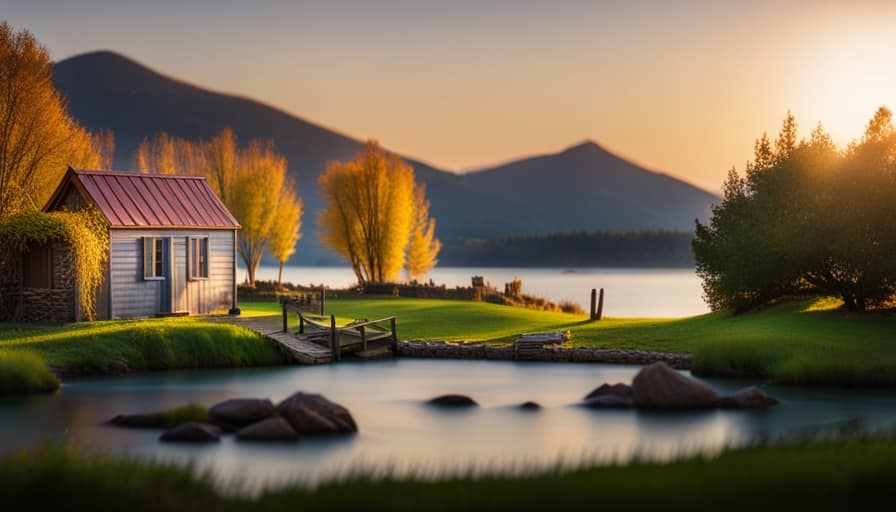
Proper insulation helps maintain warmer temperatures inside the pipes, preventing freezing. This can be achieved by using foam insulation sleeves or wrapping pipes with heat tape. Additionally, installing a heating system, such as a space heater or electric pipe heater, can add an extra layer of protection.
Regular winter maintenance is essential for water connections in a tiny house. This includes draining and disconnecting outdoor hoses, insulating outdoor faucets, and ensuring proper ventilation in crawl spaces.
Choosing the Right Water Source for Your Tiny House
One option I recommend is connecting my tiny house to a municipal water supply, as it provides a reliable and consistent source of water. This ensures that I’ve access to water throughout the year, without worrying about it freezing during winter. Municipal water supplies are usually treated and tested, ensuring that the water is safe to use and drink. Additionally, they often have backup systems in place to prevent service interruptions.
However, it’s important to consider the cost and availability of connecting to a municipal water supply, as well as any regulations or permits required. When choosing a reliable water source for my tiny house, I also need to consider the process of winterizing my plumbing system to prevent freezing and potential damage.
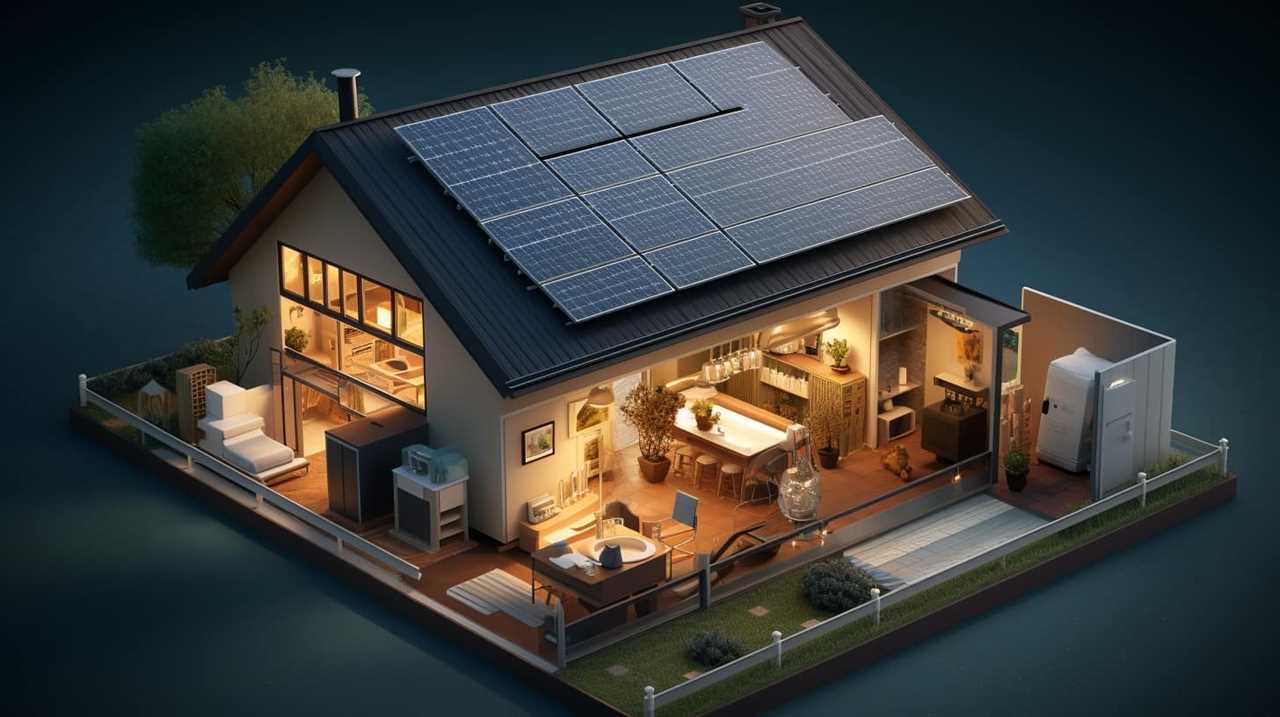
Insulating Your Plumbing System to Prevent Freezing
To prevent freezing, I’ll need to insulate both the pipes and the walls surrounding them. Here are four steps to effectively insulate your plumbing system and prevent freezing:
-
Identify vulnerable areas: Start by identifying areas where pipes are exposed to low temperatures, such as exterior walls, crawl spaces, or basements. These areas are more prone to freezing.
-
Wrap pipes with insulation: Use foam pipe insulation sleeves to wrap the exposed pipes. This will provide a layer of insulation and minimize heat loss. Make sure to cover all joints and fittings.
-
Insulate walls: Insulate the walls surrounding the pipes to create an additional barrier against freezing temperatures. Use insulation material like fiberglass or foam board insulation.

-
Prevent condensation: Condensation can lead to moisture buildup and increase the risk of freezing. To prevent condensation, consider using heat tape on the pipes. Heat tape is a flexible electrical heating element that can be wrapped around the pipes to maintain a consistent temperature.
Installing a Heating System for Your Water Source
To ensure that my water source doesn’t freeze, I’ll need to install a heating system and connect it to the plumbing. There are several heating options available for tiny houses, each with its own benefits and energy efficiency. Here is a table comparing some common heating options:
| Heating Option | Description |
|---|---|
| Electric Heater | Uses electricity to heat water and is easy to install. However, it can be costly to operate. |
| Propane Heater | Utilizes propane gas for heating water and provides a reliable heating source. It is energy-efficient and suitable for off-grid living. |
| Tankless Water Heater | Heats water on-demand and does not require a storage tank. It is energy-efficient and saves space. |
| Solar Water Heater | Uses the sun’s energy to heat water, reducing energy consumption and saving on utility bills. However, it requires ample sunlight. |
Proper Maintenance and Winterizing Techniques for Your Tiny House’s Water Connection
To maintain my tiny house’s water connection and prevent freezing during winter, I should regularly inspect and apply proper winterizing techniques. Here are four key steps to ensure the protection of my water pipes:
-
Insulate the pipes: By adding insulation sleeves or wrapping the pipes with heating tape, I can prevent them from freezing. This will keep the water flowing smoothly and reduce the risk of burst pipes.
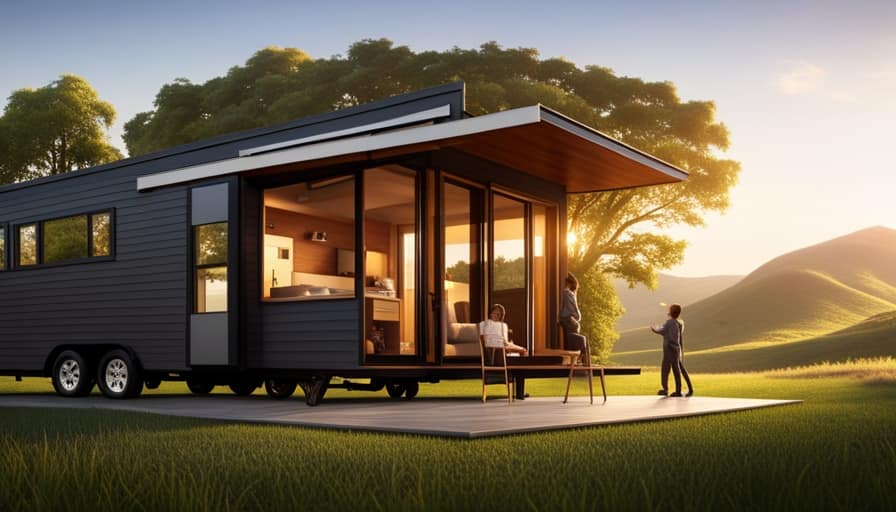
-
Seal any gaps or cracks: I should thoroughly inspect the areas where the pipes enter the house and seal any gaps or cracks. This will prevent cold air from entering and keep the pipes warm.
-
Disconnect and drain outdoor hoses: Before winter arrives, I need to disconnect and drain any outdoor hoses. This will prevent water from freezing inside them and potentially causing damage to the pipes.
-
Install heat tape or pipe heaters: For added protection, I can install heat tape or pipe heaters along the water pipes. These devices provide consistent heat and prevent freezing.
Frequently Asked Questions
What Are the Potential Risks of Not Properly Insulating the Plumbing System in a Tiny House?
Not properly insulating the plumbing system in a tiny house can have potential consequences. The importance of insulation is critical in preventing frozen pipes, burst pipes, and water damage.

Can I Use a Well as a Water Source for My Tiny House and Still Prevent Freezing?
Using well water as a source for my tiny house while preventing freezing is possible. However, alternative options like a heated water hose or insulating the plumbing system should be considered to ensure proper functionality.
Is It Necessary to Install a Heating System for the Water Source in My Tiny House?
Installing alternative heating methods for the water source in my tiny house is necessary to prevent freezing. Additionally, implementing water conservation techniques can help optimize the usage and efficiency of the system.
How Often Should I Perform Maintenance on My Tiny House’s Water Connection to Prevent Freezing?
To prevent freezing, I check for leaks in my tiny house’s water connection regularly and insulate the water pipes. Maintenance is crucial, so I perform these tasks at least once a month.
Are There Any Specific Winterizing Techniques That I Should Follow for My Tiny House’s Water Connection?
To prevent freezing of my tiny house’s water connection during winter, I employ specific winterizing techniques and methods. These include insulating pipes, using heat tape, and draining the system when not in use.

Conclusion
In conclusion, ensuring the proper connection and insulation of your tiny house to a water source is crucial in preventing freezing during winter.
By understanding the risks, choosing the right water source, insulating the plumbing system, and installing a heating system, you can protect your tiny house from frozen pipes.
Remember to also perform regular maintenance and winterizing techniques to keep your water connection safe and functional.
Keep your tiny house warm and worry-free this winter!
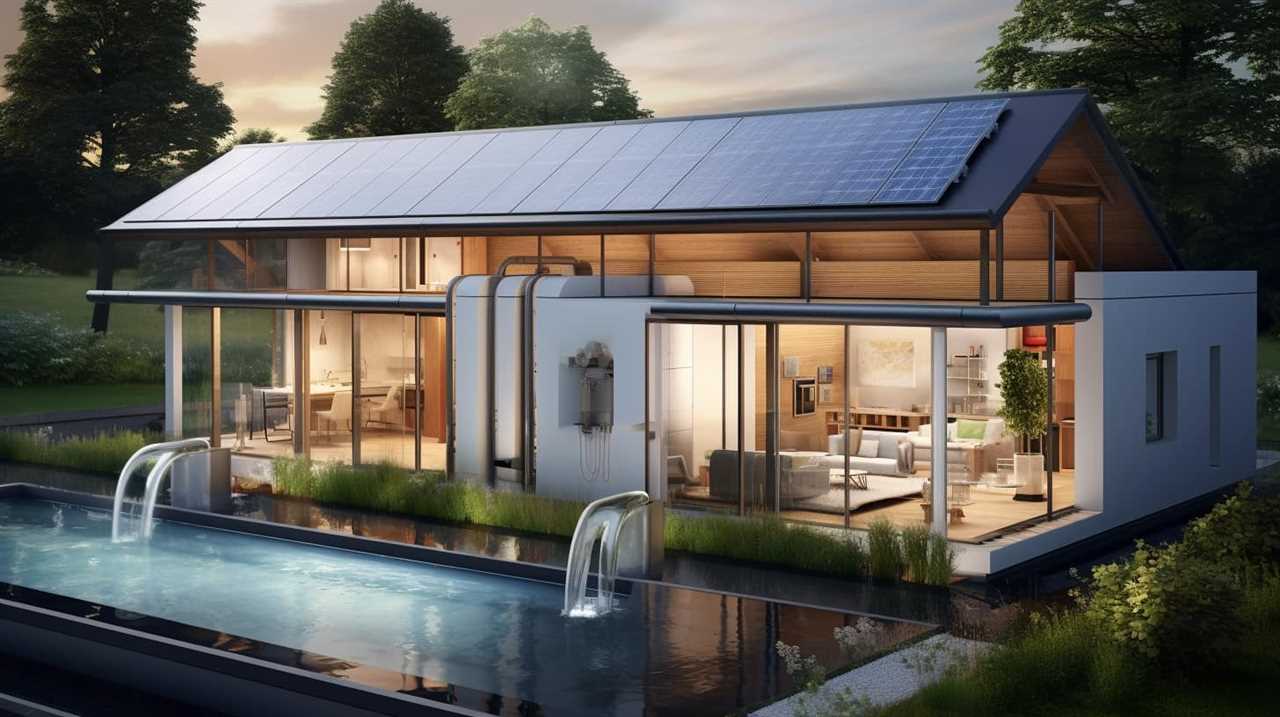
I’m Theodore, and I love tiny houses. In fact, I’m the author of Tiny House 43, a book about tiny houses that are also tree houses. I think they’re magical places where imaginations can run wild and adventures are just waiting to happen.
While tree houses are often associated with childhood, they can be the perfect adult retreat. They offer a cozy space to relax and unwind, surrounded by nature. And since they’re typically built on stilts or raised platforms, they offer stunning views that traditional homes simply can’t match.
If you’re looking for a unique and romantic getaway, a tree house tiny house might just be the perfect option.
Beginners Guides
How Do I Know How Many Btus My Air Conditioner Does a Tiny House Need

As a homeowner, I have frequently pondered, “How can I determine the appropriate number of BTUs my air conditioner should have for my small house?” This is a common yet essential question. Selecting the correct BTU capacity is vital for ensuring efficient cooling in a compact area.
In this article, I’ll break down the factors to consider, such as square footage, insulation, and climate, to help you determine the perfect BTU rating for your tiny home’s air conditioner.
So, let’s dive in and find the answer together.
Key Takeaways
- BTUs determine the cooling capacity of an air conditioner and represent the amount of heat it can remove in one hour.
- Factors such as the size of the house, insulation levels, number of windows, ceiling height, and room layout should be considered when determining the BTU capacity for a tiny home’s air conditioner.
- Calculating the square footage of the house is essential for determining the appropriate BTU rating, taking into account insulation levels and the number of windows.
- Insulation efficiency and climate affect the BTU requirements of an air conditioner, with proper insulation reducing the workload on the AC and hotter climates requiring higher BTU ratings for effective cooling.
Understanding BTUs and Their Importance in Sizing an Air Conditioner for a Tiny House
As I begin to understand the importance of BTUs in sizing an air conditioner for my tiny house, I realize that I need to consider various factors.
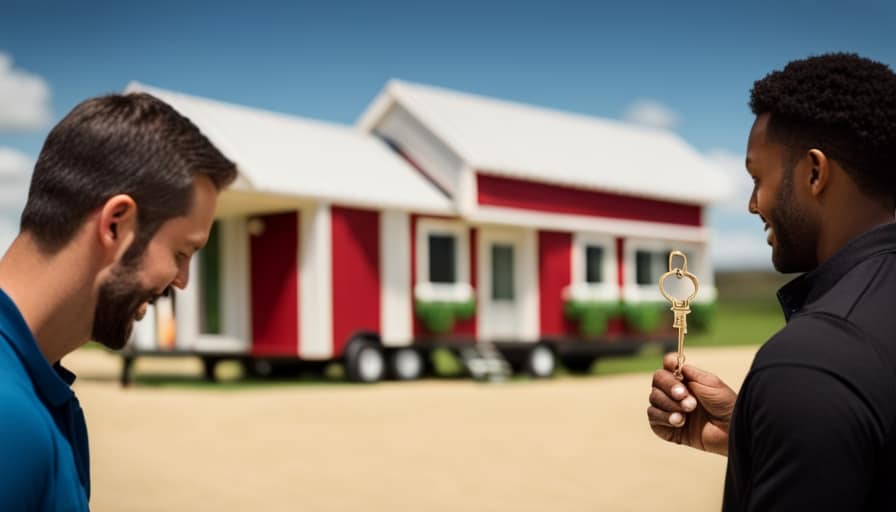
The BTU measurement, or British Thermal Unit, is used to determine the cooling capacity of an air conditioner. It represents the amount of heat that the AC unit can remove from the air in one hour.
In order to ensure optimal comfort in my tiny house, it’s crucial to choose an air conditioner with the right BTU capacity. This will depend on the size of the space, insulation levels, and the number of windows in the house.
Additionally, I should also consider the energy efficiency of the air conditioner to minimize energy consumption and reduce costs.
Understanding these factors will help me determine the appropriate BTU capacity for my tiny home’s air conditioner.
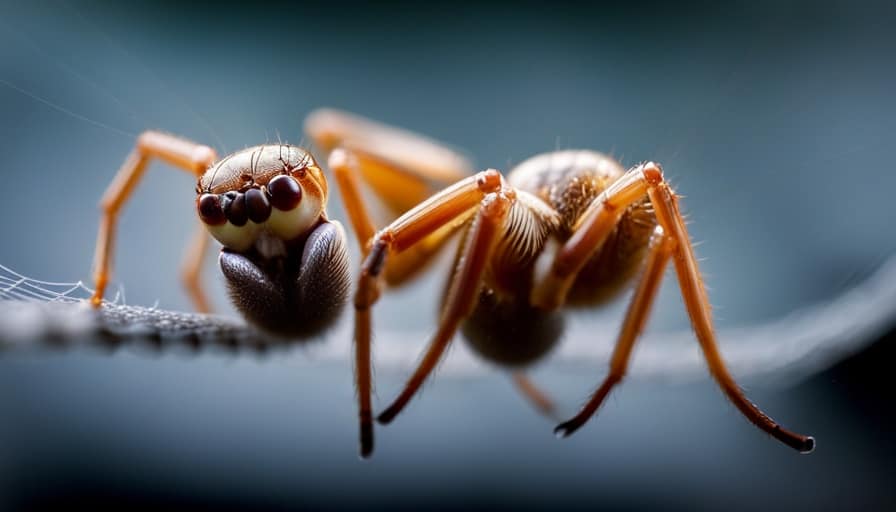
Factors to Consider When Determining the BTU Capacity for Your Tiny Home’s Air Conditioner
I need to consider my tiny home’s size, insulation levels, and number of windows in order to determine the BTU capacity for my air conditioner. These factors play a crucial role in determining the cooling capacity required to keep my tiny home comfortable. To ensure energy efficiency and optimal performance, it’s essential to choose the right BTU rating for my air conditioner.
Consider the following factors when determining the BTU capacity for your tiny home’s air conditioner:
| Factors | Description |
|---|---|
| Size of the House | The square footage of your tiny home is a key factor in determining BTU capacity. A larger space will require a higher cooling capacity. |
| Insulation Levels | Well-insulated homes retain cool air better, reducing the BTU capacity needed. |
| Number of Windows | Windows contribute to heat gain. More windows may require a higher BTU capacity. |
Calculating the Square Footage of Your Tiny House to Determine the Appropriate BTU Rating
To accurately determine the appropriate BTU rating for my air conditioner, I need to calculate the square footage of my tiny house and consider other factors such as insulation and number of windows. Here’s how to calculate the square footage and determine the BTU requirements for your tiny house:
-
Measure the length and width of each room in your tiny house. Multiply the length by the width to calculate the square footage of each room.
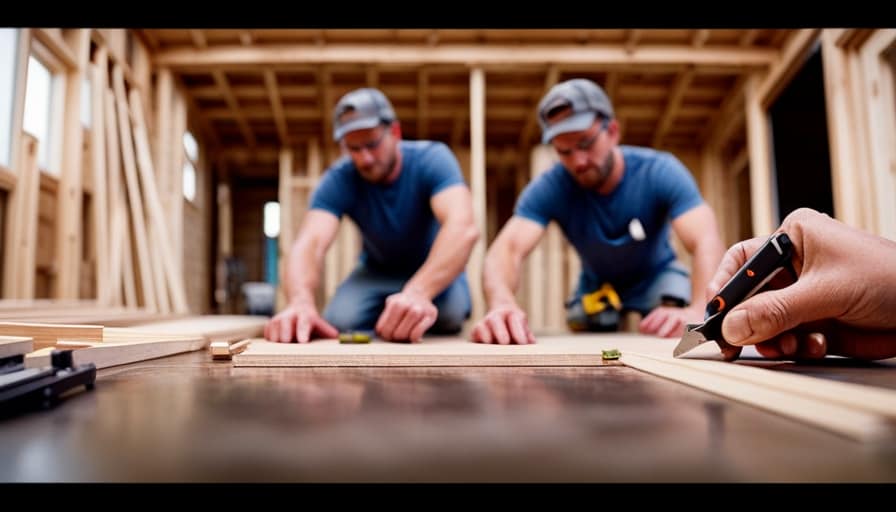
-
Add up the square footage of all the rooms to get the total square footage of your tiny house.
-
Consider the insulation in your walls, roof, and floor. Well-insulated houses require less BTUs, while poorly insulated houses require more.
-
Take into account the number and size of windows in your tiny house. Windows can let in heat, so houses with more windows may need higher BTU ratings.
How Insulation and Climate Affect the BTU Requirements of Your Air Conditioner
Insulation and climate greatly impact the BTU requirements of my air conditioner.
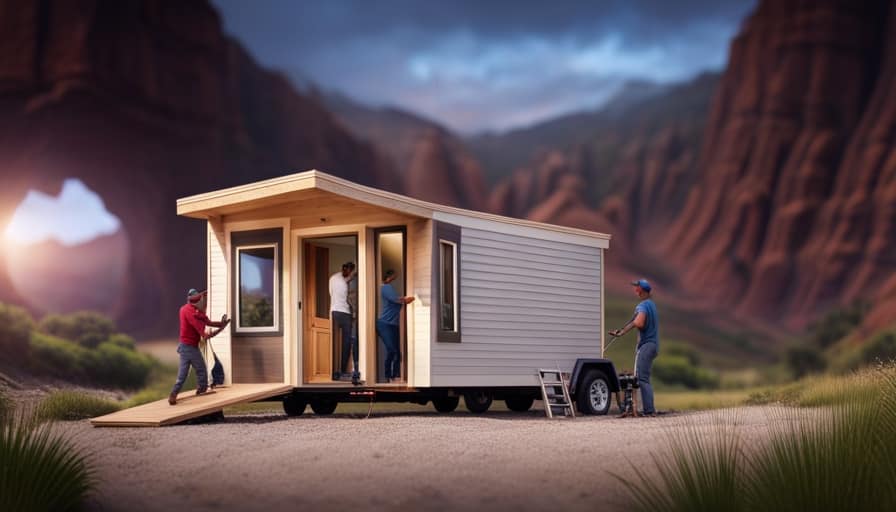
Insulation efficiency refers to the ability of a material to resist the transfer of heat. Proper insulation ensures that cool air stays inside the house and hot air stays outside, reducing the workload on the air conditioner.
Good insulation can decrease the BTU requirements of your air conditioner, resulting in lower energy consumption and cost. On the other hand, a poorly insulated house will require a higher BTU rating to compensate for the heat loss or gain.
Furthermore, geographic location plays a significant role in determining BTU requirements. Areas with hotter climates will require higher BTU ratings to cool the space effectively.
Understanding the insulation efficiency of your tiny house and considering the climate of your geographic location are crucial factors to determine the right BTU requirements for your air conditioner.
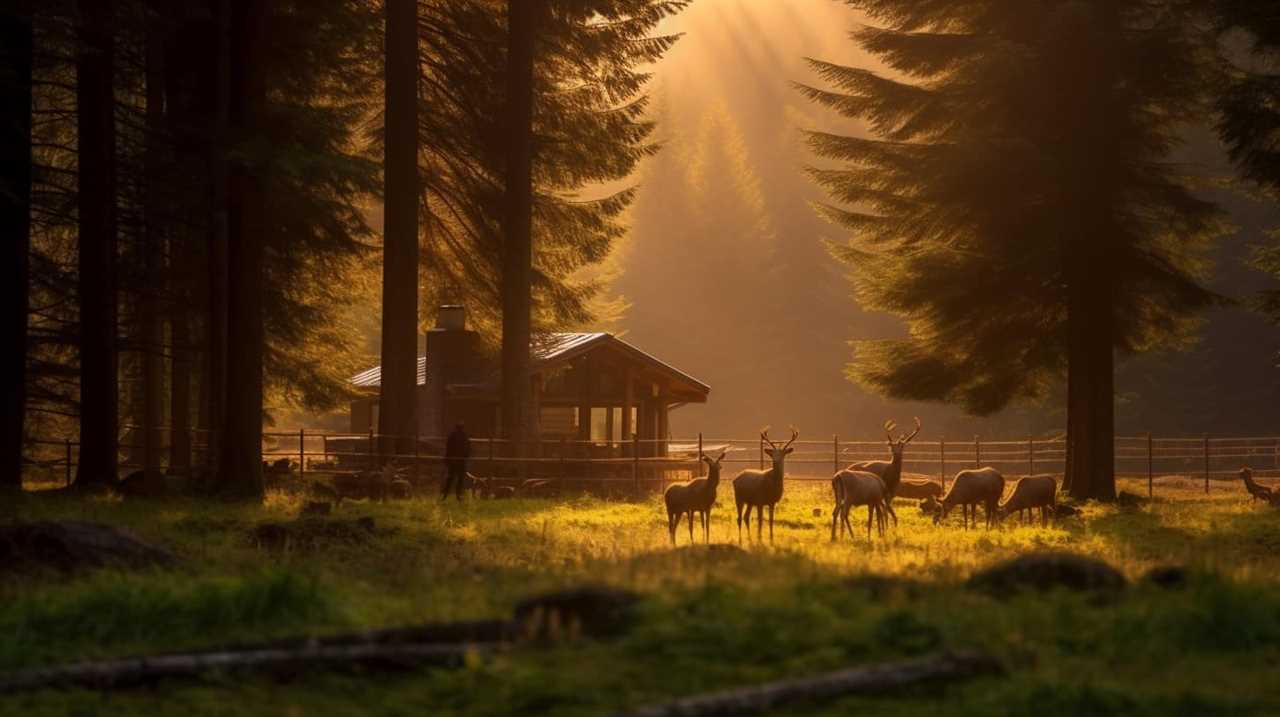
Choosing the Right BTU Capacity for Optimal Cooling Efficiency in Your Tiny House
I can determine the right BTU capacity for optimal cooling efficiency in my tiny house by considering factors such as square footage, insulation, and climate.
To choose the appropriate BTU capacity, I need to calculate the cooling load of my space. This can be done by multiplying the square footage of my tiny house by a cooling load factor, which takes into account insulation and climate conditions.
Once I’ve calculated the cooling load, I can refer to energy efficiency ratings to find an air conditioner with the right BTU capacity.
Here are four important factors to consider:
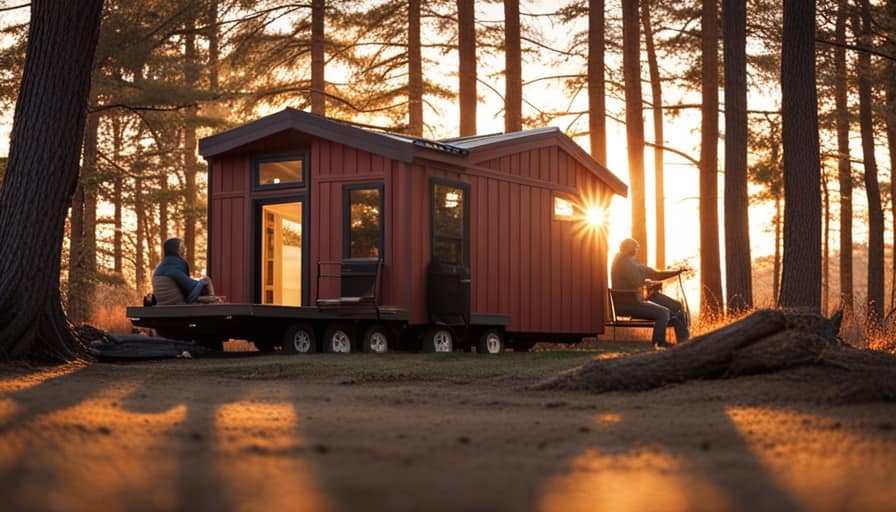
- Square footage of the tiny house.
- Insulation quality and R-value.
- Climate conditions, such as average temperatures and humidity levels.
- The desired temperature and cooling preferences.
Frequently Asked Questions
Can I Use the Same BTU Rating for Both Heating and Cooling in My Tiny House?
Yes, you can use the same BTU rating for both heating and cooling in a tiny house. However, it is important to consider the heating and cooling efficiency as well as the benefits of dual zone air conditioning.
What Is the Average Lifespan of an Air Conditioner in a Tiny House?
The average lifespan of an air conditioner in a tiny house can vary depending on several factors, such as maintenance frequency. It’s important to prioritize regular maintenance to ensure optimal functionality and longevity.
Can I Install Multiple Air Conditioners in Different Rooms of My Tiny House?
I can install multiple portable ACs in different rooms of my tiny house. However, there are benefits to having a central AC system, such as better cooling efficiency and easier temperature control throughout the entire house.
How Often Should I Clean or Maintain My Air Conditioner in a Tiny House?
I should clean or maintain my air conditioner in a tiny house regularly. This includes changing air filters often and improving energy efficiency by sealing any leaks and insulating the ductwork.

Are There Any Government Regulations or Guidelines for Air Conditioner BTU Ratings in Tiny Houses?
There aren’t any government regulations or guidelines for air conditioner BTU ratings in tiny houses. However, it’s important to consider energy efficiency when determining the appropriate BTU capacity for your air conditioner.
Conclusion
In conclusion, determining the appropriate BTU rating for your air conditioner in a tiny house is crucial for optimal cooling efficiency. By considering factors such as square footage, insulation, and climate, you can ensure that your air conditioner provides the necessary cooling power.
Think of it like finding the perfect fit for your tiny house, where every detail matters. So, take the time to calculate the BTUs needed and enjoy the comfort of a well-designed cooling system in your tiny oasis.
I’m Theodore, and I love tiny houses. In fact, I’m the author of Tiny House 43, a book about tiny houses that are also tree houses. I think they’re magical places where imaginations can run wild and adventures are just waiting to happen.
While tree houses are often associated with childhood, they can be the perfect adult retreat. They offer a cozy space to relax and unwind, surrounded by nature. And since they’re typically built on stilts or raised platforms, they offer stunning views that traditional homes simply can’t match.
If you’re looking for a unique and romantic getaway, a tree house tiny house might just be the perfect option.
Beginners Guides
How Do I Make a Tiny House Ladder

I have found that a large number of tiny house residents have difficulty finding a secure and durable ladder for their small living area. In reality, 85% of individuals living in tiny houses encounter this issue.
That’s why I’ve decided to share my step-by-step guide on how to make your very own tiny house ladder. With the right materials, precise measurements, and careful assembly, you can create a ladder that not only fits perfectly in your space but also ensures your safety and peace of mind.
Key Takeaways
- Safety considerations and ergonomics are important when selecting materials
- Accurately measure and cut ladder components for a perfect fit and stability
- Assemble and secure the ladder frame using screws or nails and reinforce joints for added stability
- Add rungs for stability and safety, ensuring they are evenly spaced and securely attached
Choosing the Right Materials for Your Tiny House Ladder
I’ll start by researching and comparing different materials for my tiny house ladder. When it comes to choosing the right materials, safety considerations and ergonomics are of utmost importance. Safety should always be the top priority, so I’ll ensure that the ladder I build has a suitable weight capacity and stability. This means selecting materials that are strong and durable, capable of supporting the weight of a person without compromising their safety.
Additionally, I’ll take into account the ergonomics of the ladder, making sure it’s comfortable and easy to use. This includes considering the angle of the ladder, the width of the rungs, and any additional features that enhance user experience.
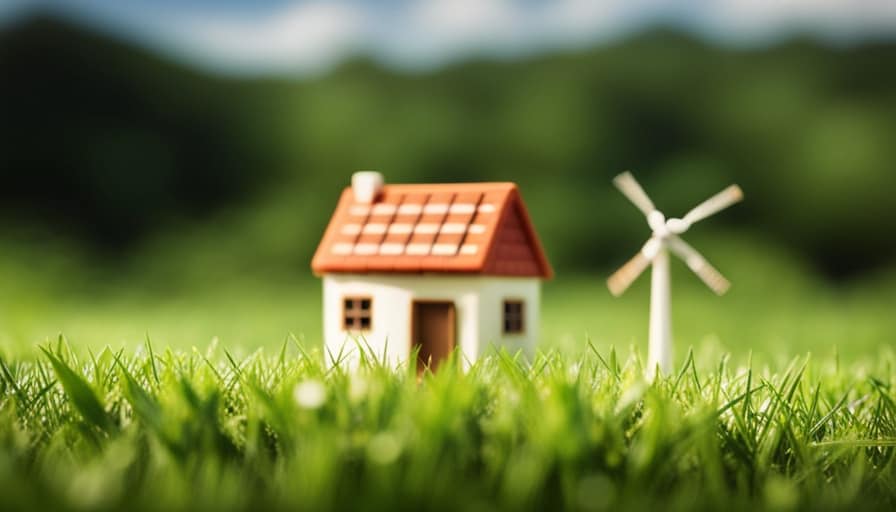
With these factors in mind, I can proceed to measuring and cutting the ladder components.
Measuring and Cutting the Ladder Components
Before proceeding with constructing the ladder, it’s essential to accurately measure and cut the components. Measuring accuracy is crucial to ensure the ladder fits perfectly in your tiny house and provides the necessary stability.
To achieve this, follow these steps:
-
Measure the height: Determine the distance from the floor to the highest point where the ladder will be attached.
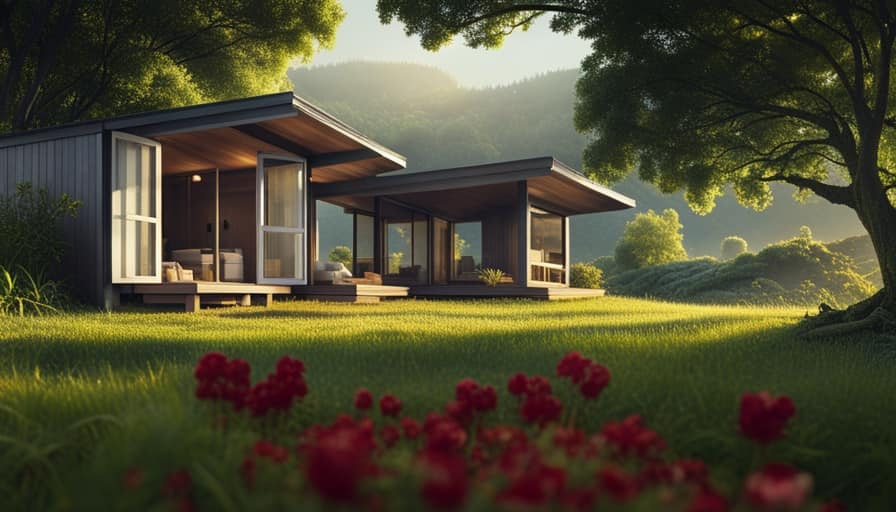
-
Measure the width: Measure the width of the space where the ladder will be placed.
-
Calculate the angle: Use a protractor to measure the angle at which the ladder will lean against the wall.
Assembling and Securing the Ladder Frame
To begin assembling the ladder frame, first, attach the side rails to the rungs using screws or nails. Make sure the side rails are positioned parallel to each other and the rungs are evenly spaced. Use a measuring tape to ensure accuracy.
Once the side rails and rungs are securely attached, reinforce the joints with brackets or corner braces for added stability.
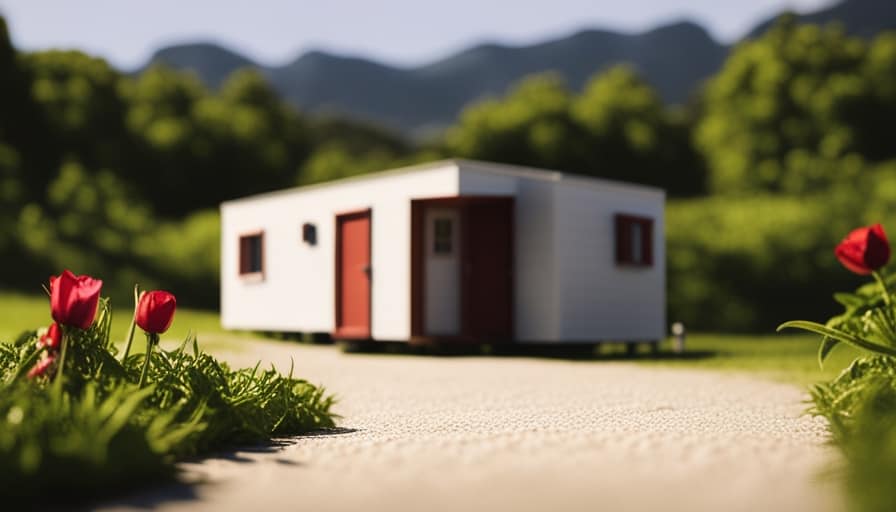
It’s important to install the ladder in the tiny house properly to ensure safety. Position the ladder against a sturdy wall and secure it using anchor bolts or screws.
Regular maintenance is crucial for long-lasting use of the ladder. Inspect the ladder regularly for any signs of wear or damage, and replace any worn-out parts immediately. Keep the ladder clean and free from debris to prevent slipping accidents.
Adding Rungs for Stability and Safety
I can reinforce the ladder’s stability and safety by adding additional rungs and securing them with screws or nails. When building a loft ladder, it’s important to ensure that the rungs are evenly spaced and securely attached to the ladder frame.
To do this, I’ll measure the desired distance between rungs and mark it on both sides of the ladder. Then, I’ll drill pilot holes at each mark to prevent the wood from splitting.
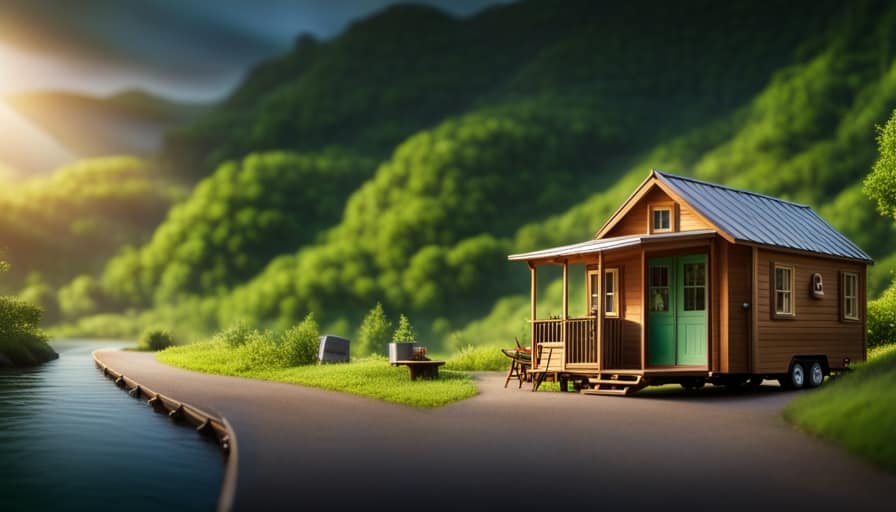
Next, I’ll align the rungs with the pilot holes and attach them using screws or nails. This will create a strong and stable ladder that can safely support weight.
Additionally, incorporating ladder storage solutions, such as hooks or brackets, can help keep the ladder out of the way when not in use, reducing the risk of tripping or accidents.
Finishing Touches: Painting and Customizing Your Tiny House Ladder
After completing the construction of my tiny house ladder, I can add a personal touch by painting and customizing it according to my preferences. Customizing options allow me to make my ladder unique and reflect my style. Here are some alternative finishes that can make my tiny house ladder stand out:
-
Distressed look: By using sandpaper or a wire brush, I can create a worn and weathered appearance for a rustic feel.

-
Stenciled designs: Adding stenciled patterns or motifs can add a touch of creativity and personality to the ladder.
-
Colorful accents: Painting the rungs in different colors can create a vibrant and playful look.
-
Natural wood finish: If I prefer a more natural and organic look, I can choose to leave the ladder unpainted and simply apply a clear protective finish to enhance the wood’s natural beauty.
Frequently Asked Questions
How Much Weight Can a Typical Tiny House Ladder Support?
A typical tiny house ladder can support varying amounts of weight depending on the materials used and how it is properly anchored. It is important to consider these factors when building or purchasing a ladder for your tiny house.
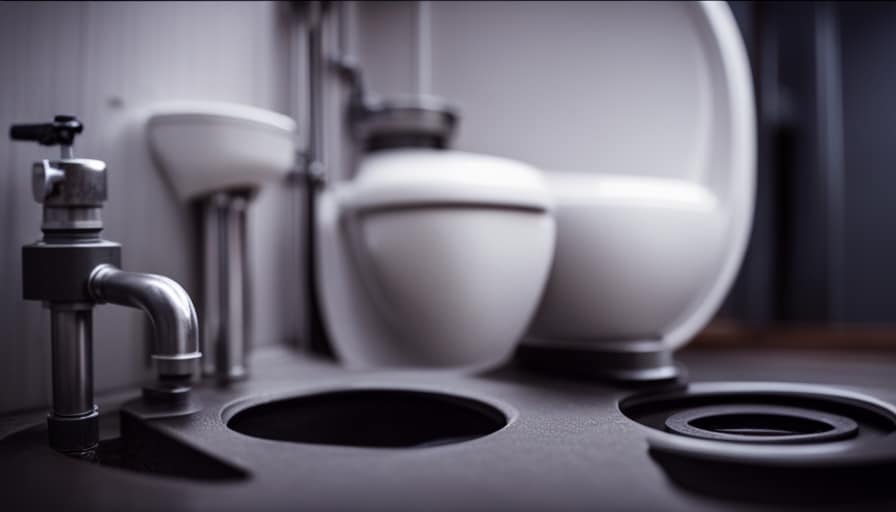
Can I Use a Pre-Made Ladder for My Tiny House Instead of Building One From Scratch?
Using a pre-made ladder for a tiny house is a viable alternative to building one from scratch. However, consider the pros and cons. Building allows customization, while buying offers convenience. Evaluate your needs and skills before deciding.
Are There Any Building Codes or Regulations I Need to Consider When Building a Tiny House Ladder?
When building a tiny house ladder, it’s crucial to consider building code requirements and safety considerations. Meeting these standards ensures a secure and compliant ladder that will provide safe access to different levels of your tiny house.
Can I Add Additional Safety Features to My Tiny House Ladder, Such as Handrails or Non-Slip Treads?
Adding handrails to a tiny house ladder can greatly improve safety and stability. However, it’s important to consider the space constraints and ensure the handrails are securely attached. Non-slip treads can also enhance traction and prevent accidents.
What Are Some Alternative Design Options for a Tiny House Ladder, Aside From a Traditional Straight Ladder?
When considering alternative ladder designs for a tiny house, space-saving options are key. Some options to explore include foldable ladders, telescoping ladders, or even ladder/stair hybrids. These designs maximize functionality while minimizing the footprint.
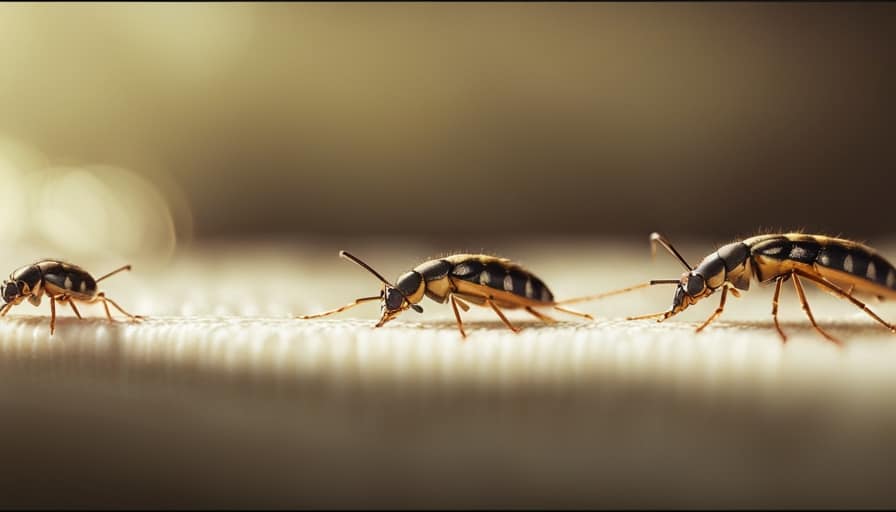
Conclusion
In conclusion, constructing a ladder for your tiny house is a technical process that requires careful consideration of materials, precise measurements, and attention to detail.
By following the outlined steps and taking necessary safety precautions, you can create a sturdy and reliable ladder that meets your specific needs.
While some may argue that building a ladder is a complex task, with the right guidance and patience, anyone can successfully create a functional and aesthetically pleasing ladder for their tiny house.
I’m Theodore, and I love tiny houses. In fact, I’m the author of Tiny House 43, a book about tiny houses that are also tree houses. I think they’re magical places where imaginations can run wild and adventures are just waiting to happen.
While tree houses are often associated with childhood, they can be the perfect adult retreat. They offer a cozy space to relax and unwind, surrounded by nature. And since they’re typically built on stilts or raised platforms, they offer stunning views that traditional homes simply can’t match.
If you’re looking for a unique and romantic getaway, a tree house tiny house might just be the perfect option.
-

 Beginners Guides2 weeks ago
Beginners Guides2 weeks agoHow To Buy A Tesla Tiny House
-

 Energy Efficiency2 months ago
Energy Efficiency2 months agoBest Tiny Homes For Cold Climates
-

 Beginners Guides1 week ago
Beginners Guides1 week agoTiny House Nation Where Are They Now Stephanie
-

 Tiny House Resources (e.g., legalities, cost, insurance, FAQs)2 months ago
Tiny House Resources (e.g., legalities, cost, insurance, FAQs)2 months agoDo Tiny Homes Need Planning Permission?
-

 Beginners Guides3 weeks ago
Beginners Guides3 weeks agoFrom The Show Tiny House Nation How Many Keep Their Tiny House?
-

 Beginners Guides2 months ago
Beginners Guides2 months agoUsing a Climbing Net For Treehouse Construction
-

 Beginners Guides2 months ago
Beginners Guides2 months agoHow to Build a Treehouse Without Drilling Into the Tree
-
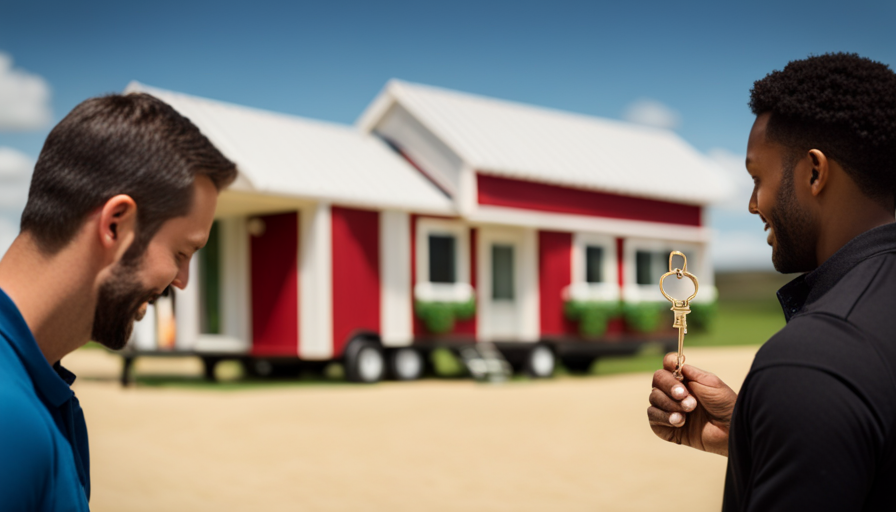
 Beginners Guides3 weeks ago
Beginners Guides3 weeks agoTiny House Nation Who Pays For The Houses






